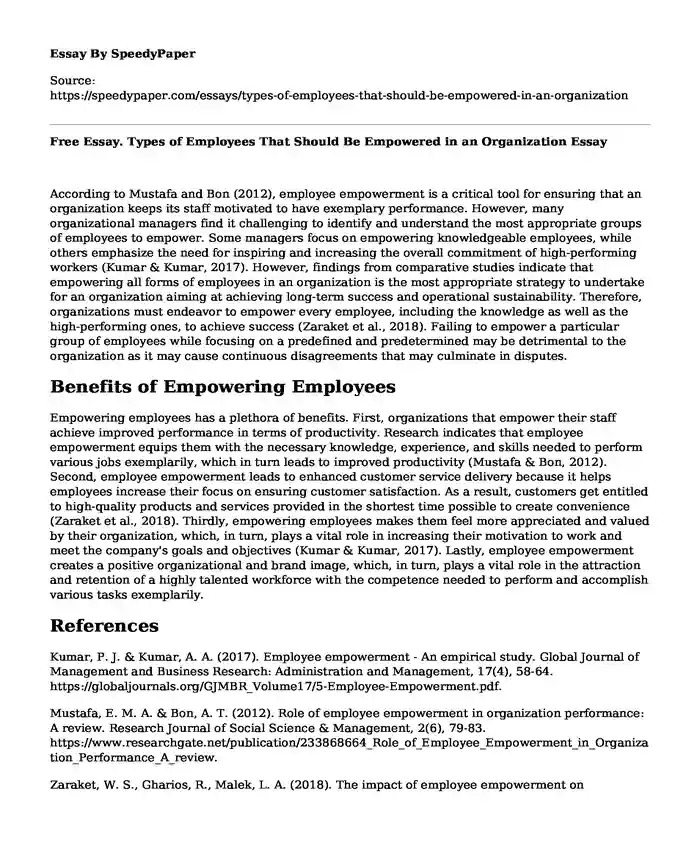
| Type of paper: | Essay |
| Categories: | Human resources Motivation Business management |
| Pages: | 2 |
| Wordcount: | 436 words |
According to Mustafa and Bon (2012), employee empowerment is a critical tool for ensuring that an organization keeps its staff motivated to have exemplary performance. However, many organizational managers find it challenging to identify and understand the most appropriate groups of employees to empower. Some managers focus on empowering knowledgeable employees, while others emphasize the need for inspiring and increasing the overall commitment of high-performing workers (Kumar & Kumar, 2017). However, findings from comparative studies indicate that empowering all forms of employees in an organization is the most appropriate strategy to undertake for an organization aiming at achieving long-term success and operational sustainability. Therefore, organizations must endeavor to empower every employee, including the knowledge as well as the high-performing ones, to achieve success (Zaraket et al., 2018). Failing to empower a particular group of employees while focusing on a predefined and predetermined may be detrimental to the organization as it may cause continuous disagreements that may culminate in disputes.
Benefits of Empowering Employees
Empowering employees has a plethora of benefits. First, organizations that empower their staff achieve improved performance in terms of productivity. Research indicates that employee empowerment equips them with the necessary knowledge, experience, and skills needed to perform various jobs exemplarily, which in turn leads to improved productivity (Mustafa & Bon, 2012). Second, employee empowerment leads to enhanced customer service delivery because it helps employees increase their focus on ensuring customer satisfaction. As a result, customers get entitled to high-quality products and services provided in the shortest time possible to create convenience (Zaraket et al., 2018). Thirdly, empowering employees makes them feel more appreciated and valued by their organization, which, in turn, plays a vital role in increasing their motivation to work and meet the company's goals and objectives (Kumar & Kumar, 2017). Lastly, employee empowerment creates a positive organizational and brand image, which, in turn, plays a vital role in the attraction and retention of a highly talented workforce with the competence needed to perform and accomplish various tasks exemplarily.
References
Kumar, P. J. & Kumar, A. A. (2017). Employee empowerment - An empirical study. Global Journal of Management and Business Research: Administration and Management, 17(4), 58-64. https://globaljournals.org/GJMBR_Volume17/5-Employee-Empowerment.pdf.
Mustafa, E. M. A. & Bon, A. T. (2012). Role of employee empowerment in organization performance: A review. Research Journal of Social Science & Management, 2(6), 79-83. https://www.researchgate.net/publication/233868664_Role_of_Employee_Empowerment_in_Organization_Performance_A_review.
Zaraket, W. S., Gharios, R., Malek, L. A. (2018). The impact of employee empowerment on organizational commitment. Journal of Human Resource Costing & Accounting 8(3), 284- 299. https://www.researchgate.net/publication/327110992_The_Impact_of_Employee_Empowerment_on_the_Organizational_Commitment.
Cite this page
Free Essay. Types of Employees That Should Be Empowered in an Organization. (2023, Apr 10). Retrieved from https://speedypaper.com/essays/types-of-employees-that-should-be-empowered-in-an-organization
Request Removal
If you are the original author of this essay and no longer wish to have it published on the SpeedyPaper website, please click below to request its removal:
- Social Media Channels Essay Sample
- Free Essay Example on Business Politics
- Essay Example: The Benefits of the Stay-at-Home Dads
- Free Essay Answering How "A Raisin in the Sun" Complicates the American Dream
- History Essay Example on Chicago Race Riot of 1919
- Essay Sample on Gender Stereotype in Children Literature
- Nietzsche and Marx, Free Essay in Philosophy
Popular categories




